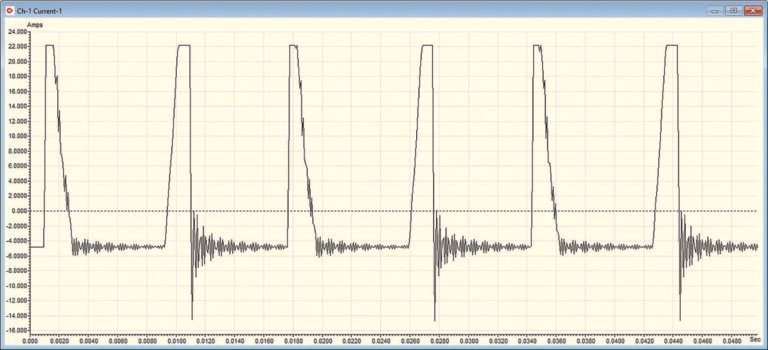Understanding Harmonics in Power Systems
What Are Harmonics In Power Systems?
An example waveform with Total Harmonic Distortion (courtesy of The Green Grid)
Harmonics in your facility’s power system pose an expensive and harmful problem. The presence of harmonics in electrical distribution systems causes increased energy waste, higher electricity costs and a noticeable decrease in equipment reliability.
As a basic example, if you’ve ever picked up your smartphone or laptop computer while connected to the charger and it felt hot to the touch, that is caused by harmonics. Or if you’ve noticed your lighting system flicker as the HVAC system activates, harmonics are at play.
Technically speaking, harmonics are currents or voltages with frequencies that are integer multiples of the fundamental power frequency (60 Hertz in the United States.) For each subsequent integer multiple, the power frequency increases by an additional 60 Hz, so the second is 120 Hz, the third is 180 Hz, and so on. These distortions are caused by non-linear loads in a facility.

What Causes Harmonics?
Harmonics are deviations from the ideal 60 Hertz phase in an electrical system. A perfect 60 Hz sinusoidal wave has no harmonic content, but in reality, electrical systems often experience distortions on both the power and non-power side.
These distortions, known as Total Harmonic Distortion (THD), are not just abstract concepts. They manifest in significant power losses and equipment stress, particularly affecting resistive elements, transformer cores, and other power quality mitigation technology in your systems.
Neutral and Ground Harmonics vs Power Harmonics
-
Neutral and Ground Harmonics
Neutral and ground harmonics relate specifically to the neutral and ground components of electrical systems. These harmonics depend on phase balance and harmonic currents, with a focus on triplen harmonics (multiples of the third harmonic), which are often present in neutral and ground systems.
Unlike power harmonics, neutral and ground harmonics can lead to additional complications, such as the skin effect. This effect, more pronounced for harmonic currents with frequencies higher than the fundamental frequency, increases the effective resistance of conductors and results in additional I2R losses.
These harmonics can also negatively impact system reliability, increasing the risk of outages, reducing power quality, and leading to higher maintenance costs.
-
Power Harmonics
Power harmonics, primarily resulting from nonlinear electronic loads in commercial and industrial power systems, create various issues, including increased power losses and potential equipment damage. These harmonics are typically integer multiples of the fundamental power frequency and manifest as voltage and current distortions in the power system.
A key aspect of power harmonics is resistive losses, often expressed as I2R losses, where I is the harmonic current and R is the conductor's resistance. This type of loss increases significantly with the squared influence of harmonic currents on power loss.
Power Losses Due to
Neutral and Ground Harmonics
The NETA World Journal recently published a peer-reviewed technical article written by Dr. Howard Penrose of MotorDoc LLC. The article and its supporting data was audited by a committee of energy professionals and outlines power losses due to neutral and ground harmonics in a facility.
Key Findings:
Non-linear loads increasingly introduce harmonic currents into neutral and ground systems
Harmonic conditions result in increased power losses and greenhouse gas emissions
Power losses from neutral and ground harmonics include Resistive (I2R), Transformer and Core, Skin Effect, and Dielectric Losses
The losses associated with neutral and ground current can also impact system reliability
Sources of Neutral and Ground Harmonics
Your facility most likely contains equipment that draws linear and non-linear loads. Linear loads draw current that is sinusoidal in nature, which presents little to no distortion in the waveform. Examples of linear loads would include transformers and motors.
On the other hand, non-linear loads draw current that is not perfectly sinusoidal, which creates waveform distortions. The presence of non-linear loads in modern industrial and commercial power systems introduces harmonic currents into neutral and ground systems. Sources of neutral and ground harmonics include:
Variable Frequency Drives (VFDs)
DC Converters, Inverters, Rectifiers
Programmable Logic Controllers (PLCs)
Uninterruptible Power Supply (UPS)
Electric Arc Furnaces
Elevators / Escalators
LED Lighting Systems
Working Industrial Machinery
Chillers / Refrigeration Units
HVAC Systems
Plug Loads Including Computers and Smart Devices
Harmful Effects of Neutral and Ground Harmonics
-
Harmonics exacerbate I2R losses and transformer core losses, increasing the temperature of of neutral conductors and distribution transformers, which can lead to premature failure and more frequent maintenance requests.
-
Continuous stress from harmonic currents, including skin effect losses and transformer hysteresis, can cause frequent breakdowns and shorten the operational life of electrical equipment.
-
Harmonic-induced resonance and power factor correction capacitor inefficiencies often result in more equipment failures, necessitating additional maintenance and increased operational downtime.
-
Inefficiencies due to harmonics lead to higher energy consumption, resulting in elevated energy bills and possible penalties from the electric utility.
-
The energy waste caused by neutral and ground harmonics translates to CO2 equivalent (CO2e) increasing a facility’s carbon footprint.
The Onics Passive Neutral and Ground Harmonic Filter
Because the Onics Passive Harmonic Filter is a passive and inductive device, it does not require 3rd-party electrical components to operate and requires no maintenance or retrofit.
The Onics Passive Harmonic Filter is not a power factor correction device. As a low pass harmonic filter, the device is set to filter harmonic waveforms at the primary frequency of 60 Hertz. The Onics device mitigates harmonic waveforms above the primary frequency (i.e. 3rd, 5th, 7th harmonics) in neutral and ground (or the non-power side) of the facility’s electrical distribution system.
Hard wired in parallel on the cold side of neutral and ground applications, there is no risk of a service interruption if the device is damaged or disconnected.
Onics Energy Solutions guarantees a minimum five percent (5%) kWh reduction after installing the Onics Passive Harmonic Filter. Most facilities experience verified energy savings of ten percent (10%) or more depending on facility profile and load configurations. All energy savings are validated by a third-party Measurement & Verification (M&V) Energy Expert based upon interval metering data from the electric utility.
Variable Frequency Drives (VFDs)
Programmable Logic Controllers (PLCs)
Motor Control Centers (MCCs)
Uninterruptible Power Supplies (UPSs)
Standard Power and Lighting Panels
The Onics Passive Neutral and Ground Harmonic Filter is a passive, inductive low pass shunt harmonic trap installed in parallel on every neutral and ground application in a facility including:





